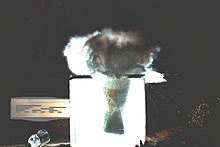Dry ice bomb

A dry ice bomb is a simple bomb-like improvised explosive device. While the simplicity and ease of construction, high bursting pressure, and sound make this dry ice activity appealing for recreational purposes, it can be unpredictable[citation needed] and dangerous[citation needed], and has led to many injuries[citation needed] - and dry ice bombs are illegal in many jurisdictions.
Overview
Dry ice bombs are commonly made from a container such as a plastic bottle, water, and dry ice. The bottle is filled about quarter full of water. Some broken chunks of dry ice are added and the container is shut tightly. As the solid carbon dioxide warms inside a bottle, it sublimates to a gas. The pressure inside the bottle increases as the quantity of gas increases with limited room to expand. Bombs will typically rupture within 30 seconds to 30 minutes, dependent largely on the temperature of the air outside the bottle.[1] A dry ice bomb may develop a frost on the bottle exterior prior to explosion.[1] After explosion, a dry ice bomb will appear to have shattered, with the overall shape of the device intact.[1]
Dangers
Dry ice bombs have some serious risks:
- Premature explosion. Burst pressure can occur within seconds, injuring the handler.
- Dry ice is very cold: −78.5 °C (−109.3 °F). The explosion can carry shards of dry ice that had not sublimed.
- The shock wave can be extremely loud and hearing damage can occur even at substantial distances.
- The blast can propel fragments of the container at very high speeds causing cuts and puncture wounds.
- Added shrapnel such as nails, marbles, and metal fragments can cause blunt force trauma to the body.
Dud bombs which fail to explode are a major safety problem. They cannot be left, yet cannot be safely approached. Unexploded bombs can be shot or otherwise ruptured from a safe distance. Injuries are common, with glass bottles in particular posing a risk of serious injury or death.[2][3][4][5]
Legality
Template:Globalize/US Dry ice bombs are illegal in some jurisdictions in the United States,[6][7] and can lead to imprisonment.[8]
- A law in California that defines "destructive device" includes a list of "weapons" including "[any] sealed device containing dry ice (CO2) or other chemically reactive substances assembled for the purpose of causing an explosion by a chemical reaction".[9][10]
- A dry ice bomb went off in the Toontown section of Disneyland in Anaheim, California on May 28, 2013, resulting in the evacuation of Toontown but causing no injuries. A Disneyland employee was arrested in connection with the blast.[11]
- In Nebraska[12] and in other areas the noise generated may violate local laws.
- Arizona prohibits dry ice bombs if there is an intent to cause injury, death, or damage to the property of another,[13] as well as their possession by "prohibited possessors" such as convicted felons and illegal immigrants.[14]
- Leaving an unexploded dry ice bomb can be construed as public endangerment.
- In Utah simple possession of dry ice bomb or similar pressurized chemical reaction bombs is a second-degree felony.[15]
Popular culture references
- A dry ice bomb was featured on MythBusters – episode 57 Mentos and Soda, which was first aired on August 9, 2006.
- The book One Day in the Life of a Fool by Jeremy M. Gates includes a story about a dry ice bomb which failed to explode as planned, and later exploded accidentally after someone took it indoors.
- An episode of Discovery channel's Time Warp features several dry ice bombs filmed on high speed camera; one on a tabletop and three in a metal tank with a transparent front. The cast believed that once one of the three bombs exploded it would blow up the other two bombs; the first bomb exploded rupturing the tank without exploding the other two 2-liter bottle bombs, and the cast and crew had to run and seek cover.
- Episode 5x23 (Iced) of CSI features a toilet bowl blown to smithereens by dry ice, first in a dorm lavatory, then in the laboratory by Greg Sanders.
- In Archer, Sterling and Lana practice using dry ice bombs as potential weapons against an ecoterrorist.
- In 999: Nine Hours, Nine Persons, Nine Doors, Junpei creates a dry ice bomb to allow June, Santa, and himself to escape from a sealed freezer.
See also
References
- ^ a b c Jill Meryl Levy (2006). The First Responder's Field Guide to Hazmat and Terrorism Emergency Response. Firebelle Productions. pp. 8–10.
- ^ "NewsLibrary Search Results".
- ^ "NewsLibrary Search Results".
- ^ "Glass shrapnel injuries to children resulting from...[J Pediatr Surg. 1990] - PubMed Result". Ncbi.nlm.nih.gov. 2009-07-01. Retrieved 2009-09-20.
- ^ "Toxicological Reviews — userLogin". Pt.wkhealth.com. Retrieved 2009-09-20.
- ^ "Charlotte: Search Results". 2006-10-24.
- ^ "> News > North County — Neighbors' long quarrel erupted". SignOnSanDiego.com. 2002-09-05. Retrieved 2009-09-20.
- ^ "Dry-ice bomb prank ends in jail". The Press. May 2, 2008. Retrieved September 29, 2011.
- ^ although dry-ice bombs rely upon the principle of phase-change, not chemical reaction
- ^ "CA Codes (pen:12301-12316)". Leginfo.ca.gov. Retrieved 2009-09-20.
- ^ Whitcomb, Dan. "Disneyland employee arrested in suspected dry ice explosion". Reuters. Retrieved 2013-05-31.
- ^ "State of Nebraska" (PDF). Retrieved 2009-09-20.
- ^ "13-3102 – Misconduct involving weapons". Azleg.state.az.us. Retrieved 2009-11-10.
- ^ "13-3101 – Definitions". Azleg.state.az.us. Retrieved 2009-09-20.
- ^ "Bomb squad demonstrates dangers of homemade explosives", KSL.com.
